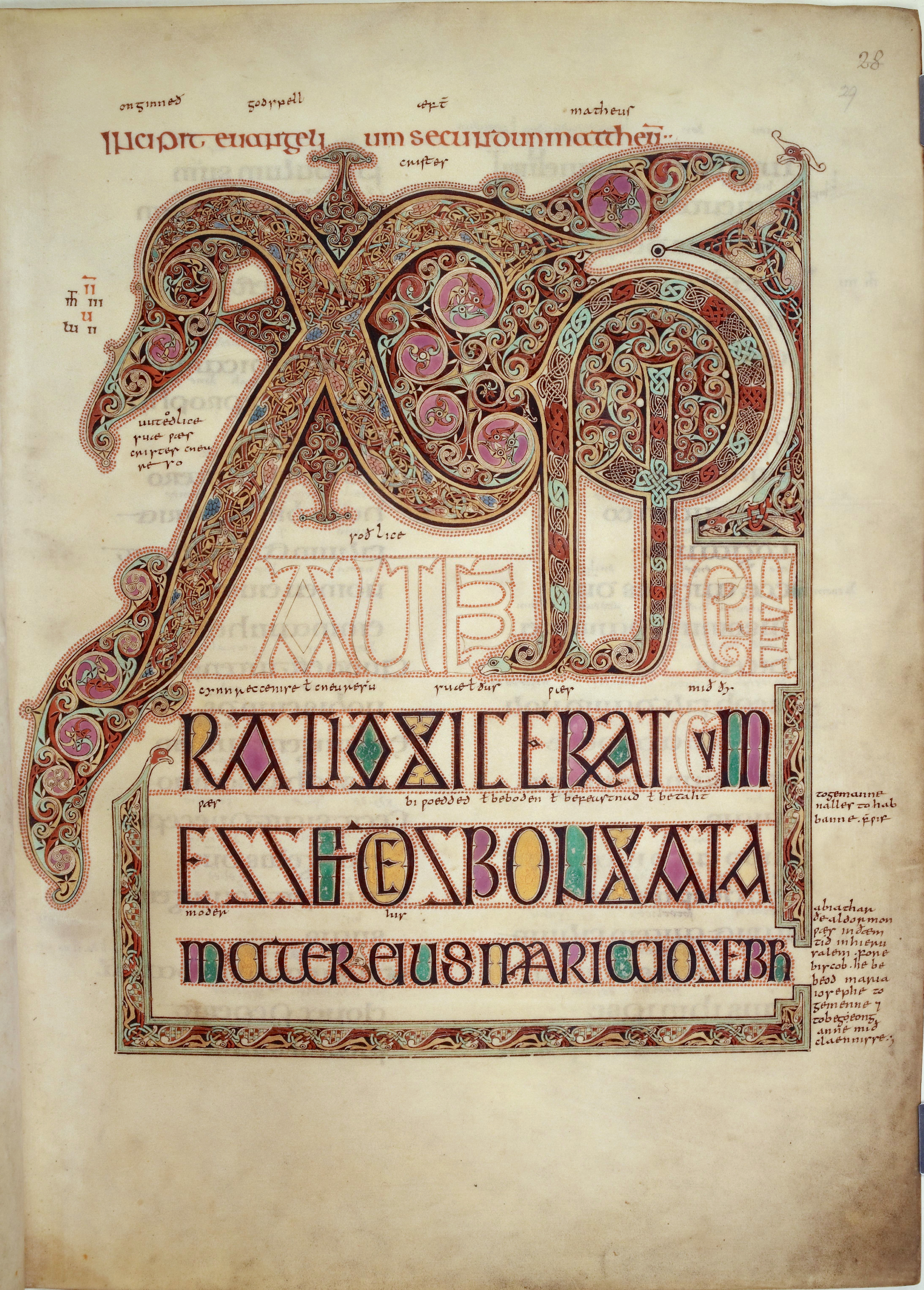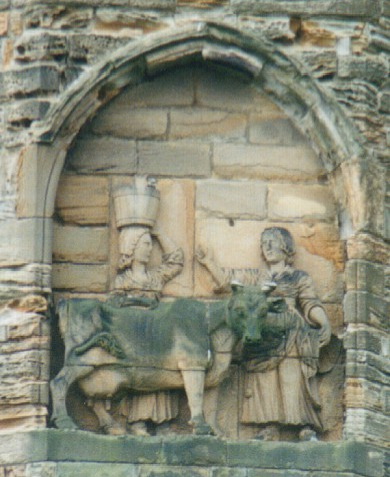|
Eadfrith
Eadfrith of Lindisfarne (died 721), also known as Saint Eadfrith, was Bishop of Lindisfarne, probably from 698 onwards. By the twelfth century it was believed that Eadfrith succeeded Eadberht and nothing in the surviving records contradicts this belief. Lindisfarne was among the main religious sites of the kingdom of Northumbria in the early eighth century, the resting place of Saints Aidan and Cuthbert. He is venerated as a Saint in the Roman Catholic Church, and in the Eastern Orthodox Church, as also in the Anglican Communion. Life A colophon added to the Lindisfarne Gospels in the tenth century states that Eadfrith was the scribe and artist responsible for the work. The Lindisfarne Gospels were the product of a single scribe and illustrator, working full-time over a period of about two years. For this reason, many historians who accept that the work was authored by Eadfrith in person date it to the period before he became bishop. Not all historians accept that he was the scri ... [...More Info...] [...Related Items...] OR: [Wikipedia] [Google] [Baidu] |
Lindisfarne Gospels
The Lindisfarne Gospels (London, British Library Cotton MS Nero D.IV) is an illuminated manuscript gospel book probably produced around the years 715–720 in the monastery at Lindisfarne, off the coast of Northumberland, which is now in the British Library in London. The manuscript is one of the finest works in the unique style of Hiberno-Saxon or Insular art, combining Mediterranean, Anglo-Saxon and Celtic elements. The Lindisfarne Gospels are presumed to be the work of a monk named Eadfrith, who became Bishop of Lindisfarne in 698 and died in 721.Lindisfarne Gospels British Library. Retrieved 2008-03-21 Current scholarship indicates a date around 715, and it is believed they were produced in honour of |
Lindisfarne
Lindisfarne, also called Holy Island, is a tidal island off the northeast coast of England, which constitutes the civil parish of Holy Island in Northumberland. Holy Island has a recorded history from the 6th century AD; it was an important centre of Celtic Christianity under Saints Aidan, Cuthbert, Eadfrith, and Eadberht of Lindisfarne. After the Viking invasions and the Norman conquest of England, a priory was re-established. A small castle was built on the island in 1550. Name and etymology Name Both the Parker and Peterborough versions of the Anglo-Saxon Chronicle for 793 record the Old English name . In the 9th-century the island appears under its Old Welsh name . The philologist Andrew Breeze, following up on a suggestion by Richard Coates, proposes that the name ultimately derives from Latin (English: Healing sland, owing perhaps to the island's reputation for medicinal herbs. The name Holy Island was in use by the 11th century when it appears in Latin ... [...More Info...] [...Related Items...] OR: [Wikipedia] [Google] [Baidu] |
Eadberht Of Lindisfarne
Eadberht of Lindisfarne (died 6 May 698), also known as Saint Eadberht, was Bishop of Lindisfarne, England, from 688 until his death on 6 May 698.Fryde, et al. ''Handbook of British Chronology'' p. 219 Life After the death of Cuthbert of Lindisfarne, Saint Cuthbert in 687, Wilfrid acted as administrator of the see of Lindisfarne. His brief tenure was confrontational. Eadberht was consecrated bishop of Lindisfarne in 688. He is credited with securing the buildings of St. Finan’s wooden church with lead, making them more durable. He is also notable as having founded the holy shrine of his predecessor Cuthbert of Lindisfarne, Saint Cuthbert on the island of Lindisfarne, a place that was to become a centre of great pilgrimage in later years. It is said that Eadberht favoured poverty and long periods of solitude and devotion as part of his service in the bishopric. He was known for his great knowledge of scripture and for giving a tenth of everything to the poor. When he died he ... [...More Info...] [...Related Items...] OR: [Wikipedia] [Google] [Baidu] |
Bishop Of Lindisfarne
The Bishop of Durham is the Anglican bishop responsible for the Diocese of Durham in the Province of York. The diocese is one of the oldest in England and its bishop is a member of the House of Lords. Paul Butler has been the Bishop of Durham since his election was confirmed at York Minster on 20 January 2014.Archbishop of York – Bishop of Durham Election Confirmed (Accessed 20 January 2014) The previous bishop was Justin Welby, now . The bishop is one of two (the other is the [...More Info...] [...Related Items...] OR: [Wikipedia] [Google] [Baidu] |
Northumbria
la, Regnum Northanhymbrorum , conventional_long_name = Kingdom of Northumbria , common_name = Northumbria , status = State , status_text = Unified Anglian kingdom (before 876)North: Anglian kingdom (after 876)South: Danish kingdom (876–914)South: Norwegian kingdom (after 914) , life_span = 654–954 , flag_type = Oswald's Stripes, the provincial flag of Northumbria and red was previously purple , image_coat = , image_map = Map_of_the_Kingdom_of_Northumbria_around_700_AD.svg , image_map_size = 250 , image_map_caption = Northumbria around 700 AD , image_map2 = , image_map2_size = , image_map2_caption = , government_type = Monarchy , year_start = 653 , year_end = 954 , event_end = South is annexed by Kingdom of England , event1 = South is annexed by the Danelaw , date_eve ... [...More Info...] [...Related Items...] OR: [Wikipedia] [Google] [Baidu] |
Northumbrian Saints
This list of Northumbrian saints includes Christian saints with strong connections to the medieval Kingdom of Northumbria, either because they were of local origin and ethnicity (chiefly Anglian) or because they travelled to Northumbria from their own homeland and became noted in their hagiography for work there. Northumbria existed from the 7th–10th centuries in what is now northern England, along with areas of the Scottish Borders and the Lothian. Its chief ecclesiastical centre was York. During the reign of king Oswald of Northumbria, an Irish monk Aidan was invited to reconvert the area to Christianity. He and other Irish monks achieved this and subsequently the Northumbrians helped to reconvert much of the rest of England and also parts of the European continent. Saints See also * List of Anglo-Saxon saints * List of Welsh saints * List of Cornish saints * List of Irish saints * List of saints of the Canary Islands Footnotes {{Saints by country Northumb ... [...More Info...] [...Related Items...] OR: [Wikipedia] [Google] [Baidu] |
Durham Cathedral
The Cathedral Church of Christ, Blessed Mary the Virgin and St Cuthbert of Durham, commonly known as Durham Cathedral and home of the Shrine of St Cuthbert, is a cathedral in the city of Durham, County Durham, England. It is the seat of the Bishop of Durham, the fourth-ranked bishop in the Church of England hierarchy. Building of the present Norman-era cathedral started in 1093, replacing the city's previous 'White Church'. In 1986 the cathedral and Durham Castle were designated a UNESCO World Heritage Site. Durham Cathedral's relics include: Saint Cuthbert's, transported to Durham by Lindisfarne monks in the 800s; Saint Oswald's head and the Venerable Bede's remains. The Durham Dean and Chapter Library contains: sets of early printed books, some of the most complete in England; the pre-Dissolution monastic accounts and three copies of ''Magna Carta''. From 1080 until 1836, the Bishop of Durham held the powers of an Earl Palatine. In order to protect the Anglo ... [...More Info...] [...Related Items...] OR: [Wikipedia] [Google] [Baidu] |
Æthelwold Of Lindisfarne
Æthelwold was a common Anglo Saxon name. It may refer to: Royalty and nobility *King Æthelwold of Deira, King of Deira, d. 655 *King Æthelwold of East Anglia, King of East Anglia, d. 664 *King Æthelwold Moll of Northumbria, King of Northumbria, d. post-765 *Æthelwold ætheling, son of King Æthelred of Wessex, d. 902 *Æthelwald, Ealdorman of East Anglia, son of Æthelstan Half-King, d. 962 Saints *Saint Æthelwold (hermit), hermit on Inner Farne, d. 699; feast kept 23 March *Saint Æthelwold (bishop of Lindisfarne), Abbot of Melrose and Bishop of Lindisfarne, d. 740; feast kept 12 February *Saint Æthelwold of Winchester, Bishop of Winchester, d. 984; feast kept 1 August Other clerics *Æthelweald, Bishop of Dunwich, mid-9th century *Æthelwold (bishop of Lichfield), Bishop of Lichfield, d. 845 *Æthelwold (bishop of Dorchester), Bishop of Dorchester, d. 950 *Æthelwold II (bishop of Winchester), Bishop of Winchester, d. 1012 *Æthelwold (bishop of Carlisle) Æthelwold ... [...More Info...] [...Related Items...] OR: [Wikipedia] [Google] [Baidu] |
Christianity
Christianity is an Abrahamic monotheistic religion based on the life and teachings of Jesus of Nazareth Jesus, likely from he, יֵשׁוּעַ, translit=Yēšūaʿ, label=Hebrew/Aramaic ( AD 30 or 33), also referred to as Jesus Christ or Jesus of Nazareth (among other names and titles), was a first-century Jewish preacher and religious .... It is the Major religious groups, world's largest and most widespread religion with roughly 2.38 billion followers representing one-third of the global population. Its adherents, known as Christians, are estimated to make up a majority of the population in Christianity by country, 157 countries and territories, and believe that Jesus in Christianity, Jesus is the Son of God (Christianity), Son of God, whose coming as the Messiah#Christianity, messiah was Old Testament messianic prophecies quoted in the New Testament, prophesied in the Hebrew Bible (called the Old Testament in Christianity) and chronicled in the New Testamen ... [...More Info...] [...Related Items...] OR: [Wikipedia] [Google] [Baidu] |
721 Deaths
7 (seven) is the natural number following 6 and preceding 8. It is the only prime number preceding a cube. As an early prime number in the series of positive integers, the number seven has greatly symbolic associations in religion, mythology, superstition and philosophy. The seven Classical planets resulted in seven being the number of days in a week. It is often considered lucky in Western culture and is often seen as highly symbolic. Unlike Western culture, in Vietnamese culture, the number seven is sometimes considered unlucky. It is the first natural number whose pronunciation contains more than one syllable. Evolution of the Arabic digit In the beginning, Indians wrote 7 more or less in one stroke as a curve that looks like an uppercase vertically inverted. The western Ghubar Arabs' main contribution was to make the longer line diagonal rather than straight, though they showed some tendencies to making the digit more rectilinear. The eastern Arabs developed the digit f ... [...More Info...] [...Related Items...] OR: [Wikipedia] [Google] [Baidu] |


.jpg)


